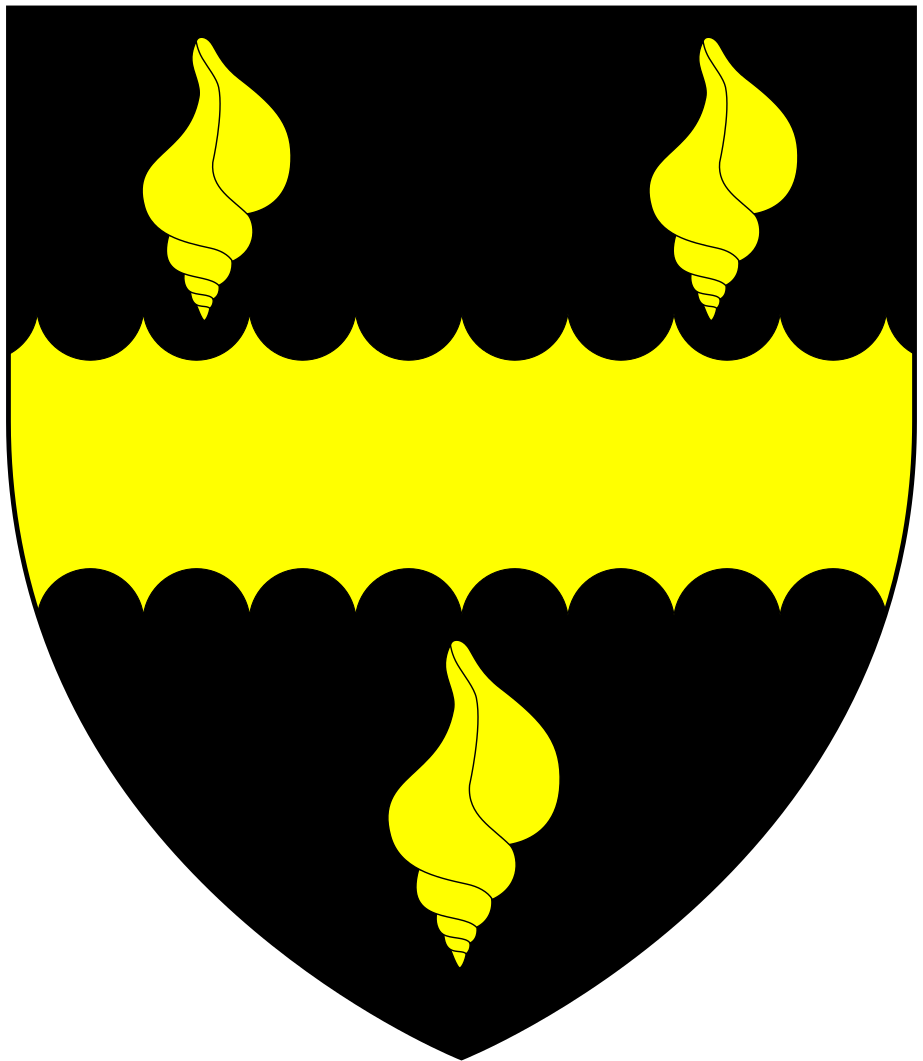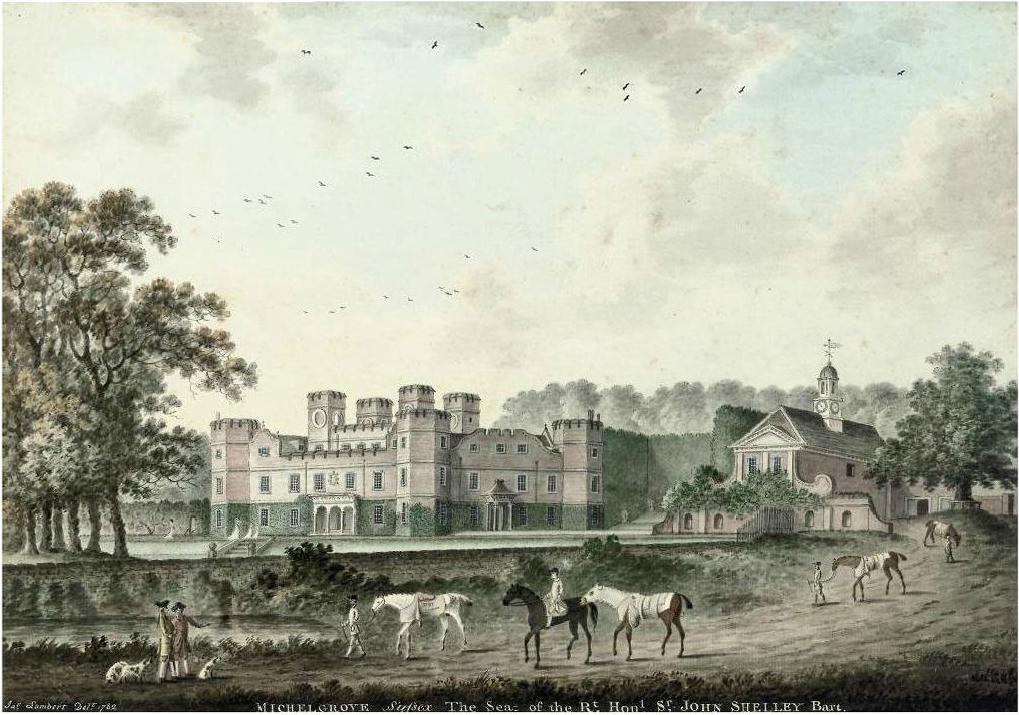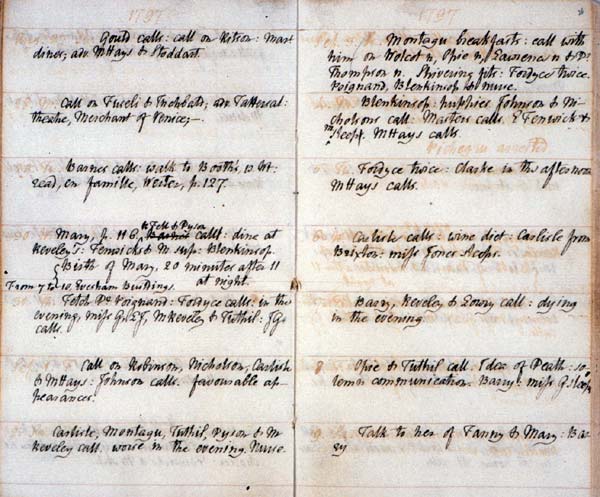|
Shelley Baronets
There have been three baronetcies created for members of the Shelley family, one in the Baronetage of England and two in the Baronetage of the United Kingdom. The three recipients of the titles represented two different branches of the family with a common ancestor in John Shelley of Michelgrove (died 1526). The most famous member of the family is the poet Percy Bysshe Shelley, although he never held any title. The holders of the third and last creation were later elevated to the peerage as Baron De L'Isle and Dudley and Viscount De L'Isle. Shelley of Michelgrove The Shelley Baronetcy, of Michelgrove in the County of Sussex, was created in the Baronetage of England on 22 May 1611 for John Shelley. The fourth Baronet represented Arundel and Lewes in the House of Commons while the fifth Baronet sat as a Member of Parliament for East Retford and Newark. Furthermore, the sixth Baronet represented Helston and Lewes and the seventh Baronet Gatton, Grimsby and Westminster. Their seat ... [...More Info...] [...Related Items...] OR: [Wikipedia] [Google] [Baidu] |
Baronetage Of England
Baronets are a rank in the British aristocracy. The current Baronetage of the United Kingdom has replaced the earlier but existing Baronetages of England, Nova Scotia, Ireland, and Great Britain. Baronetage of England (1611–1705) King James I created the hereditary Order of Baronets in England on 22 May 1611, for the settlement of Ireland. He offered the dignity to 200 gentlemen of good birth, with a clear estate of £1,000 a year, on condition that each one should pay a sum equivalent to three years' pay to 30 soldiers at 8d per day per man (total – £1,095) into the King's Exchequer. The Baronetage of England comprises all baronetcies created in the Kingdom of England before the Act of Union in 1707. In that year, the Baronetage of England and the Baronetage of Nova Scotia were replaced by the Baronetage of Great Britain. The extant baronetcies are listed below in order of precedence (i.e. date). All other baronetcies, including extinct, dormant (D), unproven (U), under ... [...More Info...] [...Related Items...] OR: [Wikipedia] [Google] [Baidu] |
Crediton
Crediton is a town and civil parish in the Mid Devon district of Devon in England. It stands on the A377 Exeter to Barnstaple road at the junction with the A3072 road to Tiverton, about north west of Exeter and around from the M5 motorway. It has a population of 8,304. However, the combined population of the parishes that make up the Crediton area is estimated to be 21,990. The town is situated in the narrow vale of the River Creedy, between two steep hills and is divided into two parts, the north or old town (People's park, Queen Elizabeth's Community College etc.) and the south and east or new town. (QECC Barnfield, Saxon Close etc.) History The first indication of settlement at Crediton is the claim that Winfrith or Saint Boniface was born here in c. 672. (text onlinhere) He propagated Christianity in the Frankish Empire during the 8th century and is the patron saint of both Germany and the Netherlands. In 909 a see was established here with Edwulf as the first bish ... [...More Info...] [...Related Items...] OR: [Wikipedia] [Google] [Baidu] |
Sir John Shelley, 6th Baronet
Sir John Shelley, 6th Baronet (18 December 1771 – 28 March 1852) was an English landowner, Member of Parliament and amateur cricketer. Career He was the son of Sir John Shelley, 5th Baronet by Wilhelmina, the daughter of John Newnham of Maresfield Park. He was educated at Winchester College, Eton College (1786–89) and Clare College, Cambridge (1789) and embarked on the Grand Tour in 1789. Shelley became 6th Baronet in September 1783 on the death of his father and inherited Michelgrove House near Patching, Sussex, which he was obliged to sell for financial reasons when he became of age. He served in the Army as an Ensign in the 2nd Foot Guards in 1790, becoming a lieutenant and captain in 1793 and Aide-de-Camp to the Duke of Sussex. He was also a lieutenant in the Petworth yeomanry in 1797. He married in 1807 Frances, the daughter and heiress of Thomas Winckley of Brockholes, Lancashire, with whom he had 4 sons and 2 daughters. He inherited Maresfield Park in Sussex in 1 ... [...More Info...] [...Related Items...] OR: [Wikipedia] [Google] [Baidu] |
Sir John Shelley, 5th Baronet
Sir John Shelley, 5th Baronet (1730 – 11 September 1783), of Michelgrove in Sussex, was a British politician who sat in the House of Commons from 1751 to 1780. He was the eldest son of Sir John Shelley, 4th Baronet and Margaret Pelham, two of whose brothers (Henry Pelham and The Duke of Newcastle) served as British Prime Minister. He entered Parliament at a by-election in 1751, probably at the first opportunity once he was legally old enough to do so, as Member of Parliament for East Retford, a pocket borough owned by his uncle Newcastle; the vacancy arose from the appointment of the sitting MP as a Commissioner of the Excise, quite possibly with the specific intention of freeing the seat for Shelley. He represented this constituency until 1768 when, having fallen out with Newcastle, he moved to represent nearby Newark (which had once also been under Newcastle's control but now belonged to another of Newcastle's nephews, the Earl of Lincoln, who had also quarrelled with his uncle ... [...More Info...] [...Related Items...] OR: [Wikipedia] [Google] [Baidu] |
Sir John Shelley, 4th Baronet
Sir John Shelley 4th Baronet (5 March 1692 – 6 September 1771) of Mitchelgrove, Sussex, was a British Whig politician who sat in the House of Commons between 1727 and 1747. Shelley was the eldest son of Sir John Shelley, 3rd Baronet and his second wife Mary Gage, daughter of Sir John Gage, 4th Baronet, of Firle, Sussex. He succeeded his father to the baronetcy on 25 April 1703. He was a Roman Catholic, who conformed to Anglicanism in 1716. He married Catherine Scawen, daughter of Sir Thomas Scawen of Horton, Buckinghamshire on 21 May 1717. She died in September 1726 and he married as his second wife Margaret Pelham, daughter of Thomas Pelham, 1st Baron Pelham MP of Laughton, on 16 March 1727. Her brother was Thomas Pelham-Holles, 1st Duke of Newcastle. Shelley was elected Member of Parliament for Arundel at the 1727 general election. He supported the Government consistently throughout his parliamentary career. He was returned unopposed for Arundel at the 1734 general elec ... [...More Info...] [...Related Items...] OR: [Wikipedia] [Google] [Baidu] |
Sir Charles Shelley, 2nd Baronet
''Sir'' is a formal honorific address in English for men, derived from Sire in the High Middle Ages. Both are derived from the old French "Sieur" (Lord), brought to England by the French-speaking Normans, and which now exist in French only as part of "Monsieur", with the equivalent "My Lord" in English. Traditionally, as governed by law and custom, Sir is used for men titled as knights, often as members of orders of chivalry, as well as later applied to baronets and other offices. As the female equivalent for knighthood is damehood, the female equivalent term is typically Dame. The wife of a knight or baronet tends to be addressed as Lady, although a few exceptions and interchanges of these uses exist. Additionally, since the late modern period, Sir has been used as a respectful way to address a man of superior social status or military rank. Equivalent terms of address for women are Madam (shortened to Ma'am), in addition to social honorifics such as Mrs, Ms or Miss. Etymolo ... [...More Info...] [...Related Items...] OR: [Wikipedia] [Google] [Baidu] |
Sir John Shelley, 1st Baronet
Sir John Shelley, Esquire, of Michelgrove, who was created a Baronet 22 May 1611. This gentleman, in the 5th of James I, alienated his Warwickshire estates, and transferred their produce to the county Sussex, where he purchased others. He married Jane, daughter of Sir Thomas Reresby, Knight, of Thriberg, and had issue. Sir John was the eldest son of John Shelley (d.1592), Esquire, and Eleanor, the daughter of Sir Thomas Lovell, Knight, of East Harling, county Norfolk. His paternal grandparents were John Shelley (d.1550), Esquire, of Michelgrove and Mary, daughter of Sir William FitzWilliam, Knight, and granddaughter maternally of Sir Richard Sackville, Knight, of Buckhurst. His paternal grandmother Mary FitzWilliam was the niece of John Sackville and the cousin of Sir Richard Sackville. Sir John was the great-grandson of Sir William Shelley, one of the justices of the Court of Common Pleas. Children of Sir John Shelley and Jane Reresby: * Sir William Shelley, Knight, who marr ... [...More Info...] [...Related Items...] OR: [Wikipedia] [Google] [Baidu] |
William Sidney, 1st Viscount De L'Isle
William Philip Sidney, 1st Viscount De L'Isle, (23 May 1909 – 5 April 1991), known as Lord De L'Isle and Dudley between 1945 and 1956, was a British Army officer, politician and Victoria Cross recipient who served as the 15th Governor-General of Australia, in office from 1961 to 1965. He was the last non-Australian to hold the position. Sidney was born into an aristocratic family and attended Eton College before going on to Magdalene College, Cambridge. He became a chartered accountant, but also joined the Territorial Army. During the Second World War, Sidney served with the Grenadier Guards in France and Italy; he was awarded the Victoria Cross in 1944 for his actions in the Battle of Anzio. He was elected to the House of Commons later that year, as a member of the Conservative Party. In 1945, Sidney succeeded his father as Baron De L'Isle and Dudley, consequently being elevated to the House of Lords. He served as Secretary of State for Air from 1951 to 1955, under ... [...More Info...] [...Related Items...] OR: [Wikipedia] [Google] [Baidu] |
Rolls Family
The Rolls family were substantial landowners and benefactors in and around Monmouth in south-east Wales. The ascent of the family to the aristocracy was through marriage. A prominent member of the family was Charles Stewart Rolls, who co-founded the Rolls-Royce car manufacturing company. The family's arms were described in 1852 as: Quarterly: 1st and 4th, or, on a fesse, dancettée, with plain cotises between three billets, sa., each charged with a lion, rampant, of the field, as many bezants; 2nd, gu., an eagle, displayed, barry of six, erminois and az.; 3rd, or, a saltier, sa., in chief, a leopard's face, of the second. John Rolls and "The Hendre" The Rolls family of Monmouth derive from John Rolls (1735–1801), son of Aaron and Elizabeth Rolls, the Grange, Bermondsey, and of the Hendre, Monmouthshire, High Sheriff of Monmouthshire in 1794. Much of his property in both Monmouthshire and London came through his marriage to Sarah Coysh (d. 1801), heiress of her brother Richard ... [...More Info...] [...Related Items...] OR: [Wikipedia] [Google] [Baidu] |
John Rolls, 1st Baron Llangattock
John Allan Rolls, 1st Baron Llangattock, (19 February 1837 – 24 September 1912) was a Victorian landowner, Conservative Party politician, socialite, local benefactor and agriculturalist. He lived at The Hendre, a Victorian country house north of Monmouth. Biography He was the only son of John Etherington Welch Rolls and his wife Elizabeth Mary Long. Elizabeth was a daughter of Walter Long of Preshaw and granddaughter of William Carnegie, 7th Earl of Northesk. Rolls was educated at Eton College and Christ Church, Oxford, later becoming Captain in the Royal Gloucestershire Hussars Yeomanry Cavalry, and was afterwards appointed honorary colonel of the 1st Monmouthshire Artillery Volunteers, later 4th Welsh Brigade Royal Field Artillery In 1868 he married Georgiana Rolls, Baroness Llangattock, Georgiana Marcia Maclean in London. She was the daughter of Sir Charles Maclean, 9th Baronet, Sir Charles Fitzroy Maclean, 9th Baronet, of Morvaren (1798–1883). They lived at '' ... [...More Info...] [...Related Items...] OR: [Wikipedia] [Google] [Baidu] |
Eleanor Shelley-Rolls
Eleanor Georgiana Shelley-Rolls (9 October 1872 – 15 September 1961) was one of the original signatories of the Women's Engineering Society founding documents. She was a keen hot air balloonist. Early life Rolls was born in Mayfair, London in 1872. She was the daughter of John Allan Rolls, 1st Baron Llangattock and Georgiana Marcia Maclean. Her three brothers, Charles Rolls John Maclean Rolls and Henry Allan Rolls all predeceased her, dying without issue, so she inherited the family estate The Hendre, near Monmouth. Career Rolls married John Courtown Edward Shelley in 1898, they both changed their surname legally to Shelley-Rolls in 1917 when she inherited the family estate at The Hendre on the death of her brother John, 2nd Baron Llangattock in 1916. Before World War One, she and her husband flew in hot air balloons, often sharing a flight with May Assheton Harbord, the first woman to hold an Aeronaut's Certificate in UK. The couple in one of the earliest Zeppelins, an ... [...More Info...] [...Related Items...] OR: [Wikipedia] [Google] [Baidu] |
Mary Shelley
Mary Wollstonecraft Shelley (; ; 30 August 1797 – 1 February 1851) was an English novelist who wrote the Gothic fiction, Gothic novel ''Frankenstein, Frankenstein; or, The Modern Prometheus'' (1818), which is considered an History of science fiction#Shelley and Europe in the early 19th century, early example of science fiction. She also edited and promoted the works of her husband, the Romantic poet and philosopher Percy Bysshe Shelley. Her father was the political philosopher William Godwin and her mother was the philosopher and women's rights advocate Mary Wollstonecraft. Mary's mother died less than a fortnight after giving birth to her. She was raised by her father, who provided her with a rich if informal education, encouraging her to adhere to his own anarchist political theories. When she was four, her father married a neighbour, Mary Jane Clairmont, with whom Mary came to have a troubled relationship. In 1814, Mary began a romance with one of her father's politica ... [...More Info...] [...Related Items...] OR: [Wikipedia] [Google] [Baidu] |








